Controversial perceptions
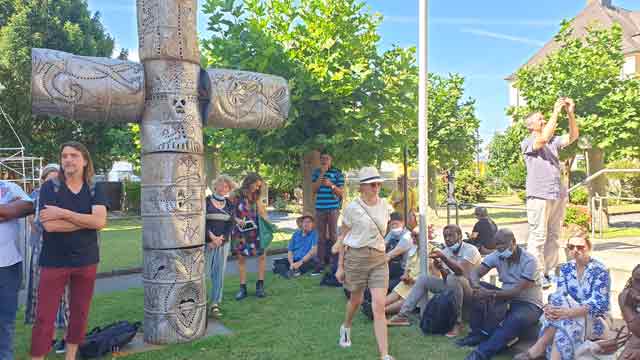
Atis Rezistans (Port-au-Prince, Haiti), various artists. Installation in front of the church St. Kunigundis, Kassel, 2022 (photo Ernst Wagner)
EVC organized a summer school at documenta fifteen with more than 50 participants mainly from Africa and Europe but also from Japan, Mexico and Brazil. During this summer school we visited the exhibitions in Kassel several times. Seeing the installation of Atis Rezistans in St Kunigundis on August 03, 2022 lead to a very controversial discussion. This discussion was so interesting that we decided to collect written statements from all participants when we were back at the venue of the summer school. Many of our participants took part and sent their statements via email the same day. These statements are published here.
Patrique deGraft-Yankson
As an African brought up in a Euro-Christian home, with an orientation which conscientized my perception of African religious artifacts as demonic, being confronted with an imagery with the semblance of African religious demonic images assembled at no other location than a church, as mighty as the St Kunigundis, in an European country was, to say the least, shocking. Momentarily, my Euro-Christian inclinations took over all artistic instincts in me. It felt like satan had triumphed over Christ in the apocalyptic battle.
But will you blame me? This is what I have been made to believe, and as an artist, you can’t blame me either for linking up the meanings of this installation to such strong religious thoughts. What I’ve been trying to process all this while is, should this installation be themed the demonization of the (Christian) church or the canonization of the (so called 'fetish') shrine? Have I been lied to all this while, or I’m being tricked into giving up a treasure which might have been bequeathed to me by mistake?
Supplement (26.8.2022)
The entire installation in the St. Kunigundis church looks exactly like one piece of a typical Ghanaian/African shrine. As it is popularly known, the colonialists described the African traditional places of worship as fetish shrines. Therefore, assembling images similar to African traditional shrine objects in a space supposed to be a church, and a sacred place of worship (according to Euro-Christian beliefs), gives the impression that, what used to be described in the colonial regime as the fetish shrine has now been elevated to a sacred place of worship. By canonization of the [fetish] shrine therefore, one would be imagining the elevation of the [fetish] shrine to an acceptable place of worship.
The last sentence in the statement above, which is actually a lingering question, seeks to question the authenticity of Euro-Christianity, one important interiorized construct in the remnants of colonization. “Have I been lied to all this while, or I’m being tricked into giving up a treasure which might have been bequeathed to me by mistake?”
In such a confused state of mind, it makes sense to wonder whether the seeming canonization of the shrine, as explained above, means that the entire idea about Christianity has always been a lie (“Have I been lied to all this while?”).
On another hand, the same confused state of mind further heightens doubts into considering the opposite: Could it not also mean that Christianity is indeed the truth (a treasure) and was handed down to us by mistake by our colonial masters (probably in their eagerness to colonize us)? What if some people are now thinking that we do not deserve this treasure, and are therefore using these installations to take our minds back to our fetish practices. In other words, tricking us into thinking that ours was the best after all, and therefore dropping the treasure (“… am I being tricked into giving up a treasure which might have been bequeathed to me by mistake?”).
As a contemporary work of art, the installation in the church of St Kunigundis definitely illicit quality aesthetical enjoyment as the artists skillfully produce forms that tell familiar religious stories through completely different creative means. On the other hand, however, the allegorical undertone of the installation, which really gives meaning to the name of the installation group, Atis Rezistans (Resistance Artists), intrigues and provokes thoughts in ways that provide outlets for extended discussion from multidisciplinary dimensions. These attributes, arguably should determine the success of the installation.
Suki Mwendwa
The installation was aggravating. It opened a wound, where as an African, spirituality has been perpetually as a ‘modern’ person been demonised by the church, and still is. We continue to perpetuate it.
Bringing the installation in a church unlocked the fear imposed by a scary ‘God’ ingrained in my system and internalised at the expense of myself and for the communication with the spiritual world. Yet it seemed to be ok to bring the ‘evilly’ described African spirituality as a mental, objectified representation in a church. It wasn’t an intellectual exercise to me. It was a splitting on my beingness, emotional, painful, confusing, actually showing back to me the ‘big lie’, that has subhumanized my existence as an African … On top of it, the installation shown back to me in a country that can be associated with the same Christianity that condemned my spiritual faith, which I’m working through the journey to reintegrate, was disturbing.
Yet, a part of me was saying, yes! It is about time you saw and accepted my spiritualism as different and maybe you get provoked. Do you feel my agony? I want you too. Yet I know it’s mine to heal. What do I do now? One feels lost and aghast. It needs time to digest. Since in a way it symbolised to me the core of the African spirituality. The Christian in the open and the traditional / indigenous in the shadow. If this art was taken to Africa, it would be condemned in the open, but would it in the shadow?
Shoni Netshia
Initially I was shocked by the smaller individual sculptural works in the space. Raised as a Christian, I immediately did not feel like engaging however, I quickly realized that the artists might want me to consider responding to the works from a different perspective. They offered me an(other) visual perspective and possibility which in my view is not ‘normalized’ or ‘acceptable’. As I interacted with the work, I began to appreciate their narratives, and exploration and visualization of spirituality which is valid to them. I enjoyed the play on who is being worshipped, respected and revered, flipping the norm and context, offering a different voice and view. The blue reflective surfaces upon which the portraits were engraved, encouraged me to reflect on my stereotypical way of viewing works which are unfamiliar to my world view, challenging me to be more open minded. A visual narrative which would never have been experienced by myself and others living outside of their society. Raising the importance of being given the opportunity to speak from one’s own background and perspective- self representation is powerful.
Hans Binder-Knott
I meant to begin by saying how the grotesque corpse-constructs that were exhibited—cobbled together from metals, fabrics and bones—juxtaposed the quiet and sacred nature of the church, when I realized they didn't. Christianity is known for the exact same thing: mortal remains of saints, clad in precious metals and fabrics. The dead here were merely looking different.
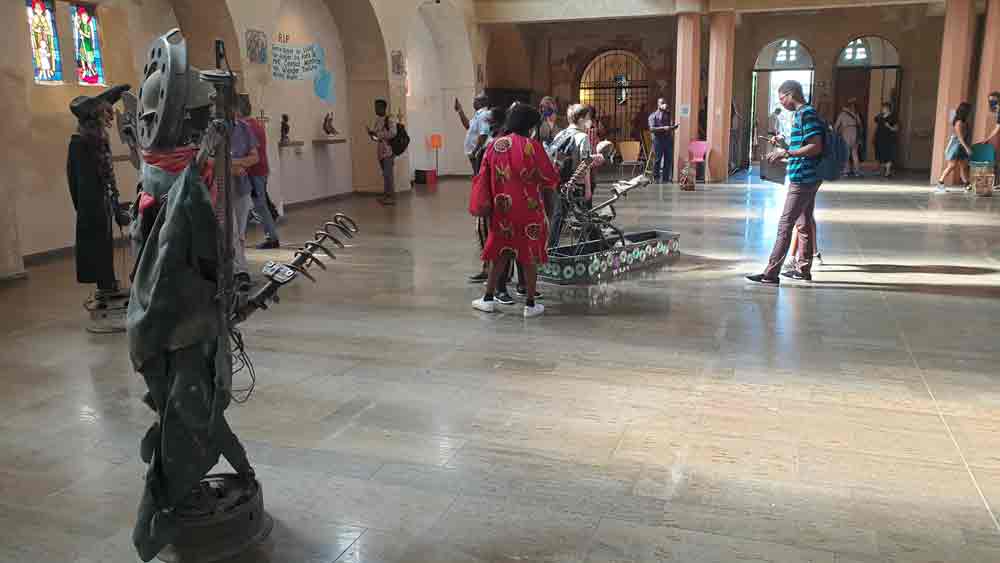
Atis Rezistans. Installation St. Kunigundis, Kassel, 2022 (Photo Ernst Wagner)
Isadora Canela
Fear, evil, death, the divine. Faith and lack, the other and the self. The desire to believe is part of the whole human narrative and seems to be able to overflow all the vulnerability of existence. When "good" and "evil" meet and share the same room one no longer knows who is who and then becomes too human and its political and oppressive standards. Still, I feel an absolute need to believe and, beyond human Morals, the coexistence of belief structures invites me to see in all a parcel of truth. Soaked by the sensation of multiple perspectives, the installation materializes in me the desire to amplify and coexist. Whether Jesus, voodoo, medicine, art or no art, past or future, I can only be sure that there is not one single answer.
Osuanyi Essel
In my encounter with the installation in the church, a multiplicity of issues emerged. These issues border on the bastardization of the church, attack on spirituality of the church (especially, the catholic faith), sexuality amongst others. First of all, the Christian church is believed to be a sanctuary and the house of God in visual form where believers congregate to bring their supplications to the supreme-being. Christians consider it as the holy-of-holy and a refuge for sinners. In this sense, believers (I) would expect artworks depicting sanctimonious stances or conjecture. On the contrary, the installations in my view presented sacrilegious representation of the Christian beliefs. At a casual glance, the installations show promiscuity, amorous advances and errotism of the priesthood and saints. To highlight this visual language, the breast and sexual organs have been glaringly exaggerated.
Lis Haddad
Coming from a country with a strong religious syncretism and not being from a religious family, seeing the images of voodoo, of hybrid beings, entities linked to religions of African origin within a church, a Christian institution, first brought me the idea of a political act, a form of equalization on the idea of the sacred and a restructuring of power.
Jayne Awuor
My first impression was that of horror. I asked myself the following questions: Were the locals in agreement with the installation? I believe there are children in the neighborhood, was this taken to consideration? Just in case? Is there a more settled approach to such installations? On a positive note, the artworks created a discourse which I think should be taken to another level.

Atis Rezistans. Installation St. Kunigundis, Kassel, 2022 (Photo Ernst Wagner)
Mary Claire Kidenda
I think the work depicts a lot of pain and suffering. The recycled materials were used in a rather crude manner. In Africa we consider church a very sacred place where we go to pray and connect with our God. I felt like the sculptors were reaching out to share their feelings and emotions to the public and to their gods. Retelling their history and educating the public about the struggles of the global south went through. It is an opportunity to tell our African stories to global north. How we run our society and the patriarchal community that it is. The importance of women in society came out strongly - portraying fertility. Compared to a few other installations like the one from Indonesia it also portrays pain, suffering.
Ruth Belinga
As I entered this church, I had several feelings.
- Firstly, I thought of the discussion with my sister who asked me last Sunday why we work on Sunday when it is "the Lord's day". My answer was: the churches in Europe have been turned into museums. No more room for God. This installation confirmed the feeling I have had since I started visiting European countries.
- Secondly, when I looked at the installation, I was shocked by what I saw. The representation of black people with skulls in a Catholic Church. Was this an illustration of what foreign religions caused in non-Western countries during colonisation? That is, the spiritual death of the colonised communities? If so, this exhibition opens up a dialogue that never really took place and in my opinion, it is the beginning of a possible reparation and reconciliation.
- Thirdly, the installation shows how colonised countries exploit new cultures alongside their traditional cultures that have never really disappeared. People transpose various cultural systems and exploit them according to their needs. In the end, the cultures live together.
Gordon Froud
I really enjoyed and resonated with this installation. I was engaged by the cultural diversity of the work and the various levels of its presentation and process. It had a level of bizarre side-show attraction to it, like seeing a car accident. Each piece held my attention and either amused, repulsed or caused me to think about it. I then reflected on the levels of the works and their placement in the installation as a whole. This allowed me to digest the images in order to understand and thus interpret what I saw. I came to the understanding that the works were about belief systems rather than religions (that rely on a God figure). The beliefs of Christianity remained as relics of an uncommissioned church. (These were slightly intervened with but not in a sacrilegious way). The Haitian Voudou figures represented their belief system of communing with the dead and embracing this by giving living attributes like sexuality, motherhood, war and power to the figures. The political figures that reflected (as mirrors and metaphorically) on the colonialisation and post-colonial situation as another form of belief system, ie that of government, power and control- perhaps under the guise of 'freedom'. The paintings of mythological figures like river goddesses, one eyed creatures etc also reflected belief systems of Mythology. The talismans and amulets evoked an idea of belief in protective objects. And lastly, the shrine with objects made of or from medicines reflected on contemporary belief systems that these can heal.
These all reflected as ways of engaging with belief systems in various cultures. I was not offended nor believed in any of them, but it made me think.
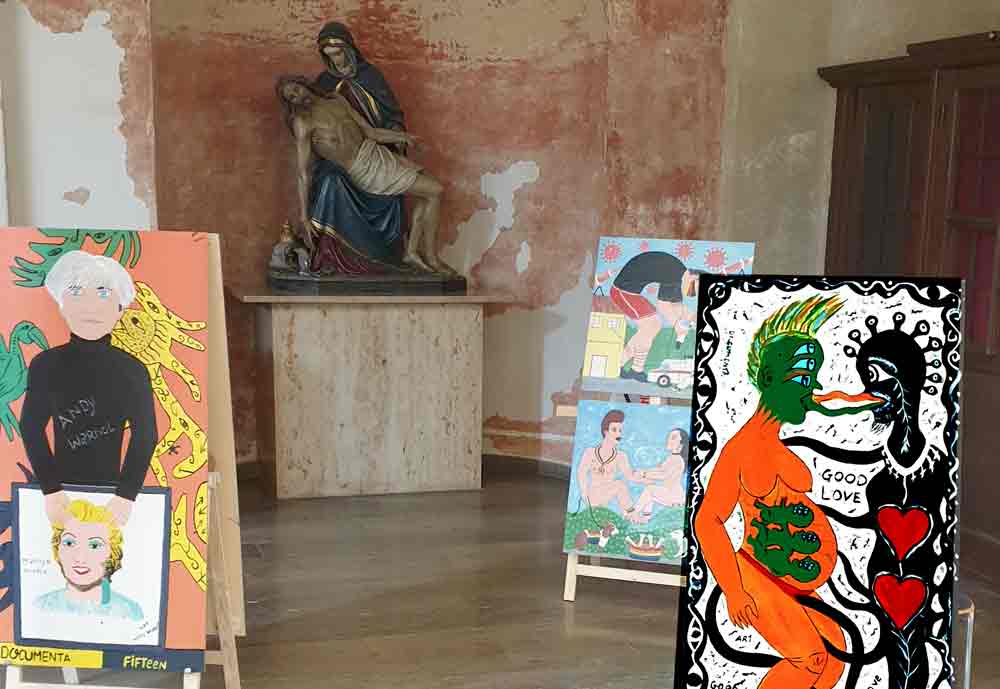
Atis Rezistans. Installation St. Kunigundis, Kassel, 2022 (Photo Ernst Wagner)
Diane Victor
My response to the works installed in the church was positive. I felt them to be a dialogue materialised between two sets of old gods, one partly the ofspring of the other and invited to the other‘s home. The flexibility of the Christian venue to facilitate the presence of works from Haiti, some of the imagery might be seen as anti Christian, is positive and perhaps such invitation might not have been as readily offered by some of the other religions reprented in the city.
I felt the work transcended notions of pure physicality commenting on human weaknesses, fears and addictions. The human need for false hope that all world religions attempt to provide perhaps in some ways, art attempts to replace this need for guidance and hope in the increasingly non secular society's of the North.
Werner Bloß
From a church-critical, perhaps more Protestant point of view, I found the installation of the Haitian works in the profaned church very coherent. There were such surprising references between the drastic depiction of the undead or the use of real human relics (skulls, bones) and the cult of relics that the Catholic Church has practised since its constitution. The subject of sexuality did not cause me any irritation either, as it was obvious, extroverted and in this respect honest and tangible, visually explicit and thus open to discussion. It exposed as an unusually drastic sign what has also been concealed, repressed and suppressed in the Catholic Church for centuries, but - as we know - was nevertheless practised, promoted and veiled in a criminal, inhuman way. The ultimately irritating moment in this personal interpretation against a Central European background lay only in the doubt as to whether the artists really wanted to reflect and explicate these contexts pictorially, as did the church, which is still the host of the exhibition. Or whether it was about something completely different, which is not recognisable or understandable when seen through Central European glasses. Possibly a confrontation was intended here that I find irritatingly harmonious. Perhaps it is about highlighting a cultural contrast that I do not want to see.
Ebenezer Acquah
My first impression was a figure that it projects spirituality of life and death made visible through the installation in an abstract figure. However, the dark imagery with seemingly open arms within a religious space makes a statement of acceptance in diversity.
Juste Constant Onana Amougui
The installation at the church was something quite impressive for me. The first thing that impressed me was to see different works (painting, sculpture, engraving, etc.) exhibited together in a church. The second thing was that I noticed that the works were from different cultures. The techniques with which they were made were also varied. I perceived in this installative time a world of exchange/interconnection between several cultures through several means of expression. I also perceived in these works forms of communication or shared language between human beings. And I found it all very expressive and lively. However, the choice of the church as the place of exhibition remained a mystery for me.
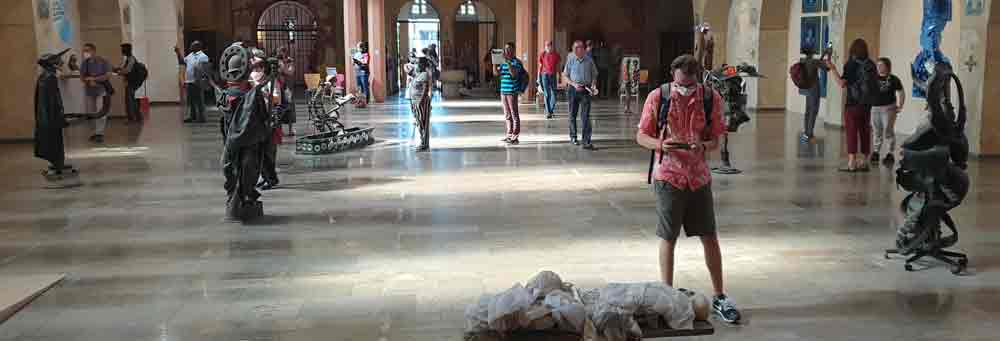
Atis Rezistans. Installation St. Kunigundis, Kassel, 2022 (Photo Ernst Wagner)
Christian Kabuß
A circle is closing. A medieval imagery that moved viewers with its narratives of life and death, redemption and punishment, finds its way back into the churches.
Gertrude Pokuah Nkrumah
I identify as a black African woman. The installation at the church reminded me of ideas about death as a universal reality for all humans irrespective of social cultural, economic and political background. From the art works, it is impossible to tell class, race, gender, and related differences. So that this makes me think of recognizing equality and unity amidst diversity of the human race. Consequently this solemn reflection instills in me a sense of tolerance and acceptance of human differences since all humans have a final eventuality.
Esther Kute
Having been brought up in a predominantly christian religion with emphasis on traditional African religions like voodooism being demonized, experiencing these mixed media sculptures from interpretations of Haitian religion was a shock to my senses. The most profound shock was voodoo being inside a christian catholic church; unheard of. What does this mean? Is this protest art? Is it the beginning of the christian church becoming more accepting of other religions? Is it encouragement to be more accepting of our traditional African religious practices? Is it a trap?
Emman Kianga
My first reaction was shock. I was not comfortable seeing such imagery in a place or context that is considered holy and sacred. It went totally against any expectations i had for a church installation. On second examination I had to question my almost automatic response to the exhibition. I had to override the prior knowledge and ideas I have about the church and the impressions the church has created in me and focus on the installation on its own merits.
I took time to breakdown what the installation may have meant to the artist, culture and context where it is drawn from. I imagined that the level or reverence I had for the church building is probably the same as what the artworks have in their home. My takeaway from that installation is that what we believe in can overshadow the process of learning new information if we allow it. Had I stormed out in disgust based on my prior beliefs then I would have lost an opportunity to see a different perspective, culture or belief system.

Atis Rezistans. Installation St. Kunigundis, Kassel, 2022 (Photo Ernst Wagner)
Odoch Pido
The installations spoke on the common grounds between Christian and non-Christian views of life. In principle sex is essential and good for life but abusive sexual practice is bad can be harmful to life. In death, all humans are equal.
Philipp Schramm
The installation is very coherent and excellently placed. Actually, it should now go on tour - the bishop's churches in Cologne, Mainz, Munich, Bamberg, etc. would be suitable stops. Then an international tour: Notre-Dame in Reims, Westminster Abbey, Sagrada Familia. I would be happy to take over the organisation and curation. Below my contact.
Paul-Henri S. Assako Assako
The installation in the church and the objects on display could be interpreted as a process of openness of the Christian church to dialogue with different belief systems. An ecumenical approach which, from my point of view, could translate a transformation of religious dogmatism: religion puts itself at the service of the human being and integrates all dimensions of human life without taboos, from the spiritual to existential needs.
Theophilus Mensah
Personal coming from a Christian background I found the installation at Kunigundis as very disturbing. Mainly because it felt so strange seeing the very exact things that Christianity thought me against fully being glorified in a church building. Most surprising was the fact that instead church items that were supposed to be displayed in the church room as objects for worship now repackaged as art works in one of the room. For me it was a very uncomfortable site to behold. I seriously would want to know the motivation behind this installation to help me understand the work. Again the installation makes me wonder if the whole idea of Christianity was a big lie told us by the western world. Because I see fetishism which was demonized by the west now being glorified by the same west. What exactly is going on………?
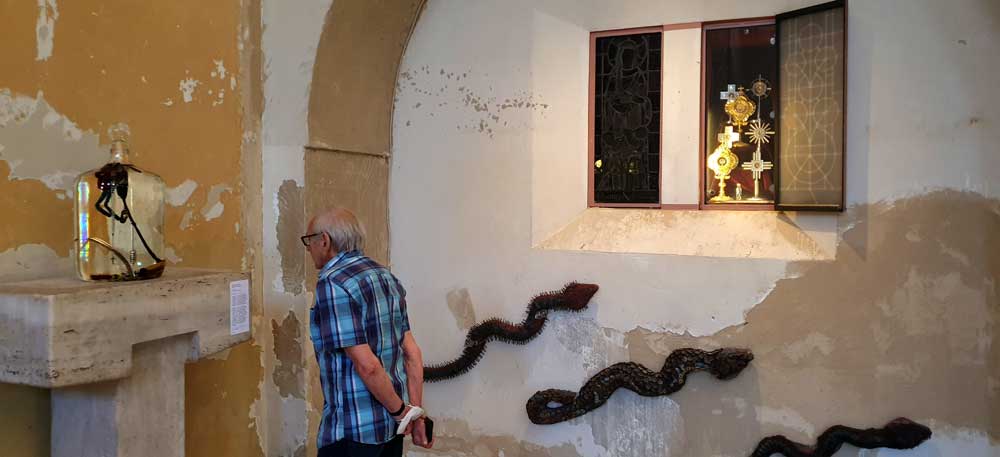
Atis Rezistans. Installation St. Kunigundis, Kassel, 2022 (Photo Ernst Wagner)
Johannes Kirschenmann
Strange worlds that are aesthetically interesting as bizarre sculptures and at the same time raise manifest questions about their cultural origins. What statement do they make today in their culture of origin, what is the intention behind the combination of the different materials, especially the human bone remains with machine segments? Is there a reference to religion, to rites?
Avi Sooful
The question arises, do I reference the artwork/installation within the context of a sacred space or do I read this as an artwork representing voodoo practice often seen as ‘sensational and barbaric’ when documented in western history? I interpret the installation as a discussion point that revisits the negation of traditional practices by colonised communities. The shock factor is immediate as the viewer is conditioned to accept Christian religious practice and sacred images of Christianity within a church building and within this context, the installation reads as blasphemous and unholy.
So, what does one make of this? In my view, the artists have reversed their initial reception of Christianity and the negation of Haitian traditional religious practices by creating an experience of horror and disgust within a Christian scared space. The practice of voodoo in contrast to Christianity is often represented as violent, barbaric, and demonic and the installation in this church reflects the colonized assuming the behaviour of the colonizer to demonstrate the emotional impact and experiences of the Haitian people when they were confronted and forced to assume a Western lifestyle.
Ernst Wagner
I grew up in a Catholic milieu in the south of Germany. The rococo of the church of Ottobeuren nourished my childhood’s imagery. Since then I have been familiar with skulls, human bones, grotesque and ecstatic figures in churches.
After visiting the Kunigundis Church, I made a startling observation: I was in the church for maybe 45 minutes - and was then surprised to hear many talking about the sexual innuendos that I had not noticed. I probably perceived the sculptures in the church in the same way as the skeletons and putti in Ottobeuren: distracted, attention drawn to random details and shapes, inattentive to symbolic meanings, but attentive to the atmospheric shaping of the church’s space by the sculptures.
This is what obviously interested me here in Kassel: What is the interaction of the installation and the space. In the sculptures I discovered many things that have been familiar to me from the Catholicism of my childhood: magic, incantation, contact with the supernatural, montage of exalted imagery (the Blessed Sacrament in the monstrance, the cross as a magical symbol, the halo of stars around the Virgin, the tabernacle, the corpse of the Pieta shown, Maria hilf! [Saint Mary help!]). As a result, I now looked with "voodoo eyes" at my own world of images shaped by Catholicism.
Teboho Lebakeng
The site-specificity of the installation is a potent aspect that frames and anchors the artworks found inside in a way that unifies their interrogations of belief systems and the roles that those systems play in different communities. From my perspective as a South African, black male it immediately conjures up the idea of tensions that can be experienced by those who through their upbringing can find themselves as members of different cultural/religious groups that hold opposing and even contradicting ideas on life, death, sexuality, healing and other aspects of the human condition.
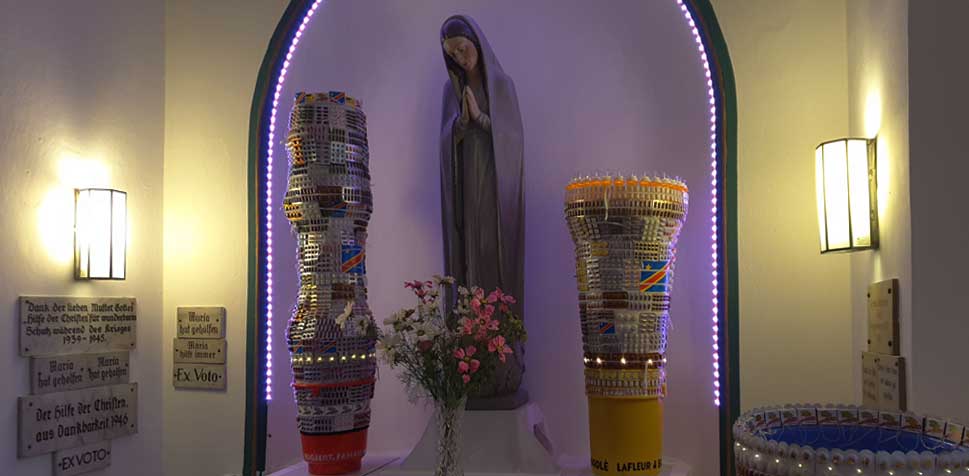
Atis Rezistans. Installation St. Kunigundis, Kassel, 2022 (Photo Ernst Wagner)
Regina Kushtanova
The sculptural installation Voodo by ATIS REZISTANS is a perfect example of what an artwork should be: it reflects culture and evokes emotion. Seeing these skulls and bones of real people who were once alive made me feel how simple and fragile we are, how short our lives are and how insignificant our everyday problems are. The church environment highlights the contrast between the afterlife, which is not guaranteed, and death, which is guaranteed. And perhaps we should all reflect on how we spend our allotted time.
Nicola Pauli
The installation by Atis Rezistans located in the abandoned church St. Kunigundis manifests an intriguing combination of several topics, such as of belief systems, spiritual practices and their historic development. Even if at first glance the nearly completely empty Christian church seems to be in juxtaposition to the presented objects, believing and historic transformations of belief systems and their practices can be perceived as common ground between the building and the installation.
Historically there never was a common ground when European colonizers forced their beliefs on the colonized. In the unique combination of the objects and specific location the installation not only shows similarities and contrasts in belief systems but also holds up a mirror to ‘Europeans’ with their historic amnesia and their set of values.
Katharina Linsel
Objects that can be defined as male and female - roles of men and women - stereotypes of men and women - sexual attributes exaggerated, ridiculed or exposed.
(Catholic) church context - masculine power is utilized and exploited at times, females are relatively irrelevant.
Techniques: ready-made objects, given a new context, mixed media, inexpensive materials and connecting techniques.
Symbol of the skull: vanity symbol --> the before and after of humanity and all living beings as the cause of religion and spiritual concepts.
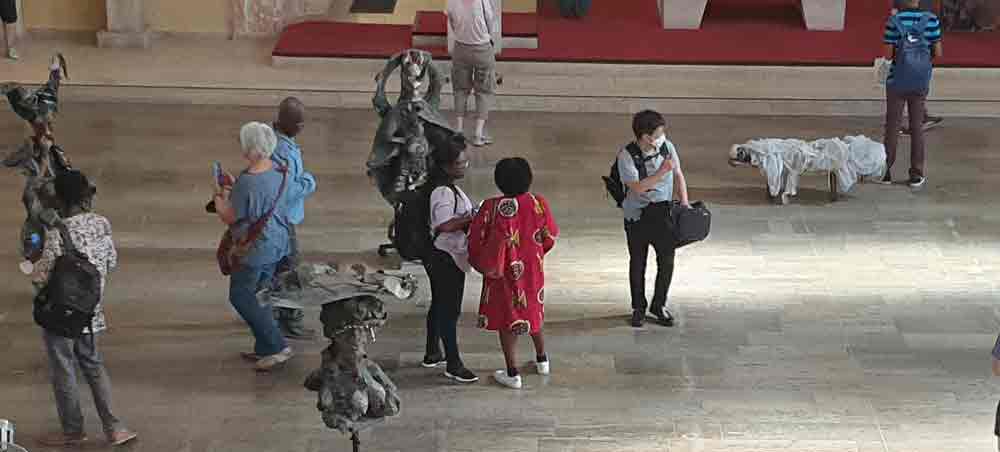
Atis Rezistans. Installation St. Kunigundis, Kassel, 2022 (Photo Ernst Wagner)
